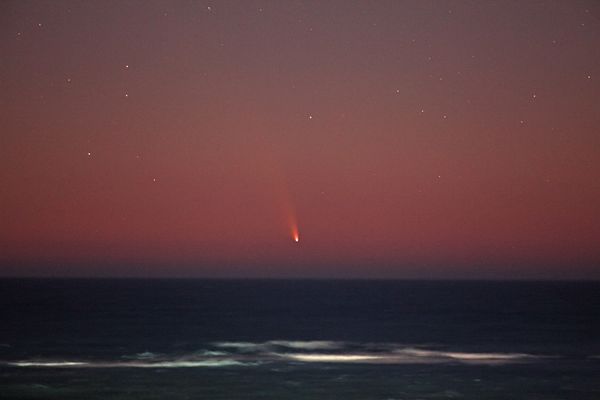Comet to Brighten Northern Skies Starting Tonight
Comet Pan-STARRS soars above the Indian Ocean on March 6, 2013.
An obscure, faint comet is finally entering the limelight. Known as C/2011 L4 (Pan-STARRS), the cosmic body is poised to light up northern skies starting tonight.
Brightening a millionfold since its discovery in June 2011, the icy interloper has already become easily visible by the naked eye from the Southern Hemisphere as a distinct tail of gas and dust.
Astronomers originally stumbled upon the comet nearly two years ago while searching for potentially hazardous asteroids. Using one of the world's largest digital cameras, on Hawaii's Pan-STARRS telescope—the comet's namesake—the team snagged a faint image of the comet while it was still more than 700 million miles (1.1 billion kilometers) away, between the orbits of Jupiter and Saturn.
What gave it away was its fuzzy appearance, which is caused by the melting ice and released gases forming a hazy shell around the comet's nucleus.
In the past few weeks the comet has made its way into the inner solar system, and it will reach perihelion—its closest approach to the sun—at a distance of 30 million miles (48 million kilometers) from the sun on March 10.
There's no chance of collision with Earth however, as the body has already gotten as close it will get to our planet, at about 100 million miles (160 million kilometers) away.
When are the best viewing times?
Soon after reaching perihelion, the comet may become visible to the naked eye for Northern Hemisphere sky-watchers low in the western horizon just after sunset on March 7, weather permitting, said Raminder Singh Samra, a resident astronomer at the H.R. MacMillan Space Centre in Vancouver, Canada.
"When viewers look for Pan-STARRS, they should have a clear unobstructed view of the western horizon, as the comet is visible for only a few minutes each night in mid-March," Samra said.
"For best results a clear view of the horizon and dark skies are recommended, and having binoculars will greatly enhance the view for observers in large, bright cities."
About a half-hour to an hour after sunset on the 12th and 13th will be the easiest time to spot the comet, thanks to a young crescent moon.
The moon will act as a convenient guidepost in helping to track down Pan-STARRS. On the 12th, look for the comet to the moon's upper left. On the 13th, the comet will appear to be hanging lower right of the moon.
How is it best seen?
It's essential to have a very clear, unobstructed view toward the western horizon at twilight.
Being close to the horizon and the glare of the sun might make spotting Pan-STARRS with the unaided eye a bit challenging, so scanning the lower sky with binoculars will help the hunt tremendously.
If predictions hold true, the comet may become at least as bright as the stars that form the Big Dipper pattern in the constellation Ursa Major, or the Great Bear. Binoculars and small telescopes will help tease out the details in the head and tail of the comet.
What should we look for?
Comet Pan-STARRS should appear as a hazy smudge of light in the twilight sky with possibly a growing tail.
Starting from the 12th, look for the comet to glide across the background of stars appearing to move night to night from the low west to the higher north until it parks itself in the constellation Cassiopeia by the end of March.
According to Samra, it's important to keep in mind that while comets are notorious for being unpredictable—and this one may brighten or fade unexpectedly—"comets like this are fairly rare, and we should try to make an effort to view it."
Andrew Fazekas
for National Geographic News
Published March 7, 2013












